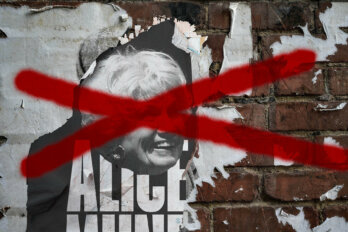In the summer of 2020, the murder of George Floyd and the ensuing Black Lives Matter protests forced the North American publishing industry, along with its global consumers, to confront its racial prejudices. They led to calls for systemic change and diversity. They led to the promotion of Black authors and to the increased placements of our books on reading lists. They led to the increase of my own book sales. But at what cost? What does it mean to be an author emotionally navigating the fact that it took a Black person’s death for some to finally decide my books were worth reading?
Listen to an audio version of this story
For more audio from The Walrus, subscribe to AMI-audio podcasts on iTunes.
A little about me: I am an academic and children’s author. I’ve written the young-adult fantasy trilogy The Effigies and The Bones of Ruin, a novel about an African tightrope dancer surviving apocalyptic Victorian London. As an essayist, I’ve also examined the emotional burdens of being a Black author, and as I’ve argued, the root of this burden is the simple fact that publishing is historically, traditionally,
Marginalized writers have long seen the need to rectify the white, able-bodied, heteronormative focus of publishing and have increasingly pushed for this in recent years. In 2014, publishing professionals including Asian American authors Ellen Oh and Aisha Saeed created the campaign #WeNeedDiverseBooks, which focused on the kinds of children’s story being produced and promoted. A year later, science fiction and fantasy author Corinne Duyvis began the #OwnVoices hashtag-turned-movement, which was meant to promote marginalized authors and content in children’s literature. Yet, despite these attempts, the industry remained set in its exclusionary ways. A 2019 survey conducted by Lee & Low Books found that an overwhelming majority of publishing staff in North America are white, heterosexual, cisgender, and able bodied. Meanwhile, a survey by the Toronto Star found that less than 20 percent of children’s books published in Canada in 2018 were written or illustrated by people of colour.
Asking the publishing industry to change its ways has been like pulling teeth. Author Linda Sue Park notes this in her deconstruction of the scarcity myth—the argument by many white authors that the newfound focus on diversity has somehow tipped the scales toward BIPOC authors and taken away their own opportunities. According to the University of Wisconsin-Madison’s Cooperative Children’s Book Center (CCBC), while the library received more American books by authors and illustrators of colour in 2019 than in 2018, books by white authors and illustrators remained overwhelmingly in the majority.
As a Black children’s author, trying to publish in an overwhelmingly white industry has required me to handle the accompanying challenges and to manoeuvre around the intrinsic mind games. I’ve had to deal with white editors telling me that my “voice” is not Black enough, not authentic enough according to their preconceptions of what authentic Blackness is. I’ve had to deal with my heritage and culture being promoted as inherently “fantastical,” thus unrealistic. I, like other Black authors, have had to listen to some wonder if Black people even read—their attempt to explain away the lack of support for Black books.
And now, here’s a new one to add the list: a victory that doesn’t quite feel like a victory.
In the wake of the Black Lives Matter (BLM) protests came a slew of support for Black life from countless industries and institutions. Whether these statements lead to sustained and systemic change remains to be seen. Publishing, at least, has pledged to meet the demand for racial justice. The days and months following the murder of George Floyd saw new hiring initiatives to combat workplace inequities and new fundraising efforts for racialized supports. Canadian publishers had similar initiatives: for example, University of Toronto Press dedicated the profits from the 2020 sales of its Black studies books to support Black Lives Matter Toronto. We also saw the increased creation of Black Lives Matter–inspired reading lists, shared by outlets like Cosmopolitan and the Washington Post.
I am not yet a well-known children’s author. Indeed, other Black Canadian writers, like Nadia L. Hohn and Nandi Taylor, have correctly noted in interviews and opinion pieces that Canada still has a long way to go in supporting us. That is why it was surprising and almost cathartic to see my books suddenly circulating on social media—there was a newfound interest in my work that hadn’t quite been there before. As elated as I was to see my books name-dropped, it lasted a few short weeks. Once the mainstream media attention toward BLM waned, so too, it seemed, did the social media posts about my books.
The sales information shared by my publishers reflected this brief burst of engagement. The percentages of books received at the CCBC by and about Black people saw small increases from 2019 to 2020. But do these statistics reflect an overall trend toward increased diversity owing to the tireless efforts of authors, readers, and publishers? Or are they at least in part due to Floyd’s murder and the events that followed? I thought of gathering further statistical information by asking fellow Black children’s authors if their book sales had increased during and after the summer of 2020, but the subject was difficult to broach. The authors I did reach out to responded with hesitance or silence. Perhaps their sales did increase due to the events of that summer. But there lies the conundrum, the emotional burden that I talk about, the one Black authors often have to face while working in an industry and living in a society where our quality of life, our success, and the manifestation of our dreams are dictated by the whims and rhythms of a white majority.
On one hand, during the summer of 2020, publishing finally began to see the need for Black art and its place in the battle against Black dehumanization. Art is not neutral—it is inherently political. Postcolonial theorist Edward Said explained how, in the nineteenth and twentieth centuries, Europeans constructed “the Orient” as their absolute ideological opposite, their “other,” through various mediums of writing such as travelogues, ethnographies, and, yes, novels. As he argued, European ideas about the Orient were constructed through European art, and this construction of the racialized other remains with us today. Said named André Gide and Joseph Conrad as among these nineteenth and early twentieth century writers for whom Africa’s exoticism made it a source of European fear and fantasy as well as a site of exploration and possibility.
Speculative-literature scholar John Rieder made a similar point in his 2008 book Colonialism and the Emergence of Science Fiction, arguing that speculative novels written in the nineteenth century reflected European anxieties, preoccupations, and so-called observations about the racialized other in their imaginings of the future, producing characters with physical traits reminiscent of scientific racism—such as the bestial, monstrous antagonists found in the works of H. G. Wells. Toni Morrison echoed these sentiments in relation to the depiction of Black people in novels. Some argue that American novels are devoid of politics—particularly if they are written simply for leisure and entertainment—but this argument falls apart looking at the history of the novel, the history of publishing, and indeed the history of the continent. As Morrison writes, it’s impossible to argue that “American literature is free of, uninformed, and unshaped by the four-hundred-year-old presence of, first, Africans and then African-Americans in the United States.”
In the words of Canadian critical race scholar and lawyer Joshua Sealy-Harrington, “Race is a story.” For many years, Black people have suffered at the hands of art created by white artists who have depicted us as not quite human. W. E. B. Du Bois understood this when he wrote his then controversial speech “Criteria of Negro Art,” in 1926. In it, he asserts that “all Art is propaganda and ever must be, despite the wailing of the purists. I stand in utter shamelessness and say that whatever art I have for writing has been used always for propaganda for gaining the right of black folk to love and enjoy. I do not care a damn for any art that is not used for propaganda.” Black art created by Black artists has the power to fight back against centuries-long depictions of our inhumanity. This is important. The increasing acknowledgement of this fact is one of the victories to come out of the summer of 2020.
On the other hand, the psychological trauma of knowing that your sales came at such a high cost is undeniable. As a Black author, what do I do with the knowledge that the cruel and senseless murder of a Black human being led to an increased interest in books by Black authors like myself? And why do Black people need to be brutalized and even killed so publicly and so horrifically before some entities decide that Black stories are worth reading?
We have been writing for centuries. Our work has been published for centuries. We’ve faced scrutiny and unrealistic expectations. We’ve brushed up against racism. As Black authors, we are constantly having to compete for limited space on agents’ client lists, editors’ acquisition lists, and consequently, bookstore shelves. What changed after Floyd’s murder that suddenly made our work worthy in these eyes? It wasn’t the quality, the dedication to our craft, or the earnestness of our efforts. That much is certain.
The change in perspective took a man’s death. It took Black authors once again being forced to come face to face with our disposability. It took our collective traumatization and retraumatization as the story captured the news cycle for months. This feels cruel and unfair. And, judging by the publishing industry’s increasing misuse and corruption of our diversity discourse as well as its slow movement toward equity, it becomes clear that the collective light bulb switched on after Floyd’s murder can be switched off again—if it was ever truly on in the first place. Many people ordered books by Black authors from Black-owned bookshops during that summer—so many that new print runs were ordered and many titles had wait lists. As reported in Literary Hub, a few months later, when the new copies were ready and shipped, many shop owners found that those same buyers never even bothered to pick up their books. What will the whims of the white reading majority dictate next?
These considerations don’t just expose the publishing industry as a racialized space; they point to the simultaneous hypervisibility and invisibility of Black life itself. The history of publishing and the political nature of art cannot be understood without taking into account the relative powerlessness of marginalized artists who do not own the keys to social, political, and economic power. It seems we can never be given anything without a healthy dose of pain to go along with it.





